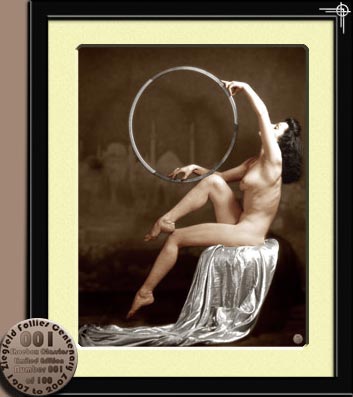
Ziegfeld Follies Girl representing Scheherazade from The Arabian Nights
On a personal note, today is my birthday. It is hard to be serious on such a foreboding occasion, especially when the magic number now exceeds the number of varieties of Heinz pickles. Besides (myself), the sun is shining and it is spring and silliness is in the air. [Isn’t it silly that we drop the ‘y’ to make silliness gramatically correct?] Since I have been preparing a powerpoint for a class on the history of ways in which the human body has been depicted, especially in the art of Adam and Eve in Eden, I have come across a number of Google-ill-begotten images, some of which are hilarious, some risque and some poignant. Take, for example, the picture above, which is not off a current porn site but actually a Ziegfield Follies Centennial print, indeed the first in the series.
So what do you see here? The body is meant to stand out, a side view of a nude. One breast is prominent, the head is thrown back so the long brown or black (as though it matters since it is not blonde) hair falls down the back. She appears to be holding her breath, as the ribs are etched and thus seemingly stretched. I think her eyes are closed, One foot parallels the other in a way that not accidentally draws the viewer’s eyes toward the properly hidden genitals. The white robe, silk no doubt, obscures the seat; it is the platform holding up and forth the artistic beauty of the naked female body. The scene itself is suggestive, not unlike many an ad in regular newspapers and magazines, but not pornographic, unless you assume that any depiction of the naked body is necessarily about lust. I imagine that Schererazade here is dreaming of the caliph, perhaps dreaming up the next night’s tale to fend off her destruction.
But if it were not a prettty girl drawing our attention, would not our eyes be captivated by the circle framing the center of the picture, the flat, see-through world of her imagination, stretched out by her arms and resting gently on her knee. And inside this round frame what do you see? Two minarets architecturally astride a mosque’s dome. But these are dim images, as if seen through a mirror darkly. They are colorless, as though filtered by a sandstorm. Yes, dull religion is present in the background, but the vitality of life we focus on is the whiteness of the skin and the flowing robe. Is it meant to be a stark either/or contrast or a reminder that behind the way we look at bodies there is always a moral background framing our dreams?
This is all fantasy, probably male fantasy for the most part, but it is also a poignant reminder that the imagination gravitates towards flesh, even the unattainable kind except with eyes closed. Some argue that life is a stage and we are all bit players for the most part. A fellow named Shakespeare (no not Sheikh Zubayr) said it well, did he not:
O, she doth teach the torches to burn bright!
It seems she hangs upon the cheek of night
Like a rich jewel in an Ethiope’s ear;
Beauty too rich for use, for earth too dear!
So shows a snowy dove trooping with crows,
As yonder lady o’er her fellows shows.
The measure done, I’ll watch her place of stand,
And, touching hers, make blessed my rude hand.
Did my heart love till now? forswear it, sight!
For I ne’er saw true beauty till this night.
(William Shakespeare – Romeo and Juliet: Act 1, Scene 5)
There is so much to be dreamed out of a folly. Are we foolish to do so? Ask yourself, were you offended at seeing this image here? Did you wonder why a site about Islam and the Middle East would put up what looks at first glance to be just another girlie picture? This image is what you make it to be, of course. So is morality and we would be foolish to think otherwise. Day needs night and night announces day. The balance is how we live on and off the stage of our individual lives. That’s why we need daydreams. That’s why we need the imagination of the Arabian Nights. That’s what musings on one’s birthday are for.
Daniel Martin Varisco